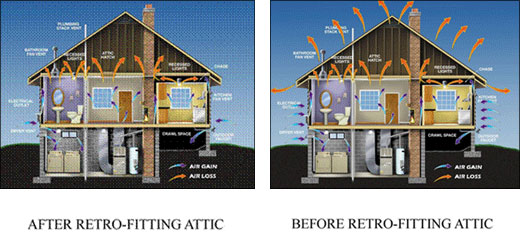|
Why retrofit an existing
home with spray polyurethane foam?
The vast majority of existing homes in the world are insulated
with a air-use insulator ( fiberglass, cellulose ). They are
expected to insulate our homes and buildings based on the
assumption of dead air and only the principles of advection
and convection (R-factor). The problem is that the forces
working against the envelope of the building are much more
powerful and diverse than the air use insulator can control.
Let us take for instance the R-30 loose fill in most attics;
it takes just a couple of hours for the radiant heat from the
attic to build to 140 degrees and go completely through the
R-30 and start heating up your house and running up you power
bill, most especially if your HVAC system and ducts are in the
attic. When the sun goes down and your house should be cooling
off the air-use insulator is holding the heat in and therefore
not allowing the house cool off for several hours.
Winter time is the time of year that conventional insulation
really becomes an energy eater. When the air in a home is
heated the house becomes a hot air balloon, even though it
will not raise off the ground, all the same physics of lift
apply. When you heat the air; it wants to rise and it passes
through the loose fill or batt insulation in your attic
flooring. When this happens it takes the temperature and
moisture that has accumulated in the living envelope and moves
into the attic. Because of the air mass expanding (static
pressure) in the summer months, we have had to vent the attic
to relieve the pressure outside instead of it pushing into the
living area. These same vents allow the pressure, temperature,
and moisture you just paid to have in your home to escape.
When air leaves the vents in the roof, replacement air must
come in, bringing in cold air to be re-heated (Air Loss/Air
Gain).
In retro fitting an existing home you must look first at where
your money will be most well spent. The roof area of a house
consumes as much as 35% of the energy needed to heat and cool
a home. The crawl space of a home can consume up to 30% and
the walls, windows and doors the balance. By spraying open
cell polyurethane foam against the roof deck of the building
you will stop all the radiant energy from entering the
structure. In climates like those in the south, the high
humidity from outside is prevented from entering the house. If
there is no radiant energy there is no expanding air mass. If
there is no expanding air mass you do not need vents. By
eliminating the vents, you have now stopped your heat rise
loss in the winter months and have kept your HVAC system from
working overtime in the summer.
The roof area of a house should be the first area sprayed as
it is the largest energy consumer of the envelope. The floor
or crawl space should be next. We advise not trying to
re-insulate walls as the payback on a 18% loss would be cost
prohibitive and not practical.
When we heat and cool the air in our houses we are doing so
because we donít like what is going on out of doors. When we
do this it puts the building envelope in direct opposition to
the most powerful force on earth, the atmosphere.
Installing open cell polyurethane foam allows your HVAC system
to work less which saves you money. The energy savings payback
on installing this type of foam is 3-7 years.

You now understand the
benefits of retrofitting your home with spray foam insulation,
so call today or click here
for a free estimate on our services.
>> back to homeowners page
|